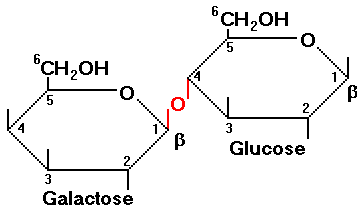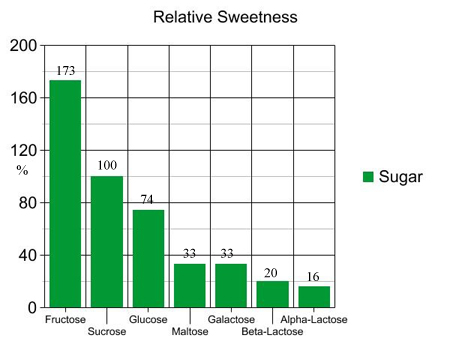Lactose Facts
Lactose, or milk sugar, is the major carbohydrate found in the milk of all mammals. Making up 2-8% of bovine milk solids by weight, the amount present varies depending on the cow's diet, the stage in the milking cycle (lactation), and the overall health of the animal (among other factors).
Also known as 4-O-Beta-D-galactopyranosyl-D-glucopyranose, lactose, (below), is classed as a disaccharide, that is, it's made up of equal amounts of two simple sugars, or monosaccharides, glucose and galactose. (In case you hadn't noticed, words ending in -ose typically describe sugars). Cane or beet sugar (sucrose), another disaccharide, is made up of equal portions of glucose and fructose.

To further complicate matters, lactose comes in two forms or isomers- alpha and beta, the difference being based on where a particular hydrogen atom and a hydroxyl group (-OH, an oxygen with a hydrogen attached) on the glucose portion end up in relation to one another.
Interestingly, alpha and beta-lactose morph back and forth into one another due to a phenomenon called mutarotation. The rate of this see-sawing back and forth is influenced by a number of conditions including the concentration of lactose, the temperature and the acidity, or pH, of the milk. At room temperature, the ratio of isomers is about 40% alpha to 60% beta.
Another odd thing about lactose is that it's much less sweet than either of its two components, glucose and galactose. See below for a comparison:

The slightly sweeter taste of beta-lactose is likely due to it's higher solubility in water - it dissolves on the tongue more readily, but still ranks quite a bit lower than the next sweetest sugar, galactose. Both isomers of lactose play a big role in the pharmaceutical industry- in their solid form, they're often used as fillers or 'excipients' in tablets and capsules.
In order for lactose to be utilized as a food source, it must first be broken down into its two monosaccharides, which are firmly joined together by a bond called a Beta-(1,4) glucosidic linkage. The enzyme, lactase, produced by epithelial cells in the brush border (microvilli) of the small intestine, cleaves this scary-sounding connection quite nicely.
Unfortunately, lactose not broken down by lactase and absorbed will eventually reach the large intestine. Once there, the resident microbes will attack it, producing carbon dioxide, hydrogen, methane and lactic acid in the process. This can cause elevated water retention in the colon, which, coupled with the gases produced, can cause the unpleasant symptoms familiar to those who are lactose intolerant: flatulence, abdominal pain and diarrhea.
Lactose intolerance is big business, as any search for 'lactose' on Google will show, but many adults are unaware that they have a genetic variation which allows them to produce lactase in their intestines throughout life. Often, such people will react adversely to pasteurized dairy products and mistakenly assume they're lactose intolerant, when in actuality, they're reacting to allergenic, heat-denatured proteins and fat globules corrupted by the homogenization process.
A tasty alternative for these folks, and those of us not lucky enough to make our own lactase, is to try fermented, raw, grass-fed milk products like kefir and yogurt. The lactobacilli that give them their tangy taste consume most of the lactose and convert it to lactic acid, while boosting the nutrient content at the same time.